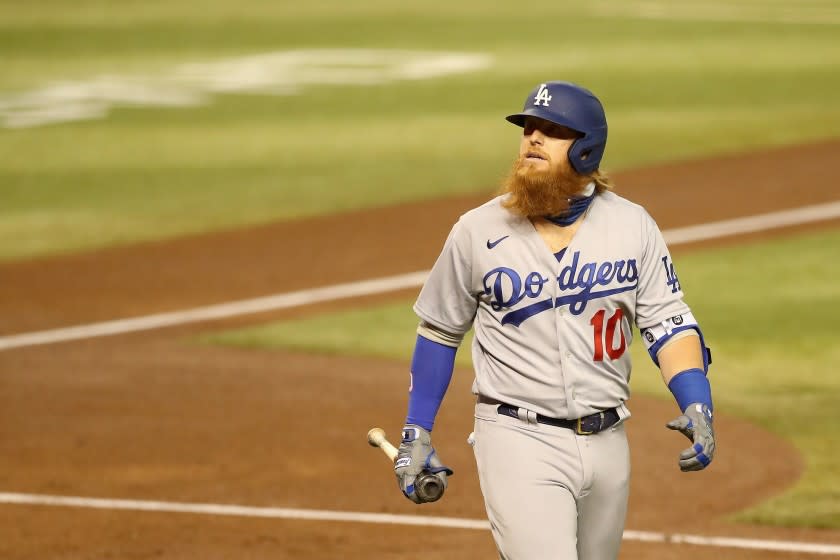Dodgers' hitters aren't getting whole picture because of video room ban

Justin Turner whiffed for strike three in the third inning of the Dodgers’ 6-5, 10-inning win over the Angels on Saturday night at Angel Stadium when color analyst Orel Hershiser made a subtle observation on the television broadcast: Turner will have to wait until after the game to study a replay of the at-bat.
In a normal year, Turner could have gone straight to a video room located somewhere between the dugout and clubhouse to take a look at his plate appearance if he wished. Was the umpire’s strike zone accurate? Was his swing in sync? Did he see that pitch from Andrew Heaney correctly? It’s a tool major leaguers have increasingly utilized to make in-game adjustments in recent years. This season, it’s not an option.
Major League Baseball barred player access to video rooms as part of the lengthy operations manual devised to attempt to stage this season amid a pandemic. The rule was implemented to avoid the possibility of people spreading the novel coronavirus in close quarters. For the Dodgers, that has fundamentally changed hitters’ approaches.
“I see it as going back to the basics,” Dodgers utilityman Kiké Hernández said during training camp last month. “It’s going to go back to having that feel of old-school baseball.”
Talk of barring access to video rooms — where club officials responsible for deciding whether to challenge plays watch the game — bubbled over the offseason and into spring training after the Houston Astros’ cheating surfaced. Some feared teams could use the rooms to relay signs to hitters.
In February, Dodgers shortstop Corey Seager, an ardent in-game video advocate, said he spent 65-70% of innings at Dodger Stadium in there. He believed he needed the constant visual feedback to succeed.
He hasn’t needed the access this season. Seager entered Saturday batting .305 with four home runs and a .936 on-base-plus-slugging percentage. Seager acknowledged the lack of access could prevent players from overthinking. But he remains a supporter of the resource.
“It has a huge impact, whether you're going good or bad,” Seager said. “You like to see where pitches were, where you thought they were, where they actually are. Even in the zone, you sometimes get confused. Just checking on little setup things and little corrections that you would normally make throughout the game, you’re not really able to.”
Video remains an important instrument for the Dodgers. Players are given footage of upcoming pitchers and their previous at-bats to study away from the ballpark. Hernandez said he spends most of his days on the road watching the clips as they’re discouraged from leaving their hotel rooms.
“It depends on how things are going for you at the time,” Dodgers utilityman Chris Taylor said. “If you're grinding, there might be something you want to look at. But if things are going good and you're swinging it well, then it's nice just to not have to nitpick at every little thing on video.”
Dodgers manager Dave Roberts likes that it forces players to stay in the dugout and watch the game live rather than in a room in the bowels of a ballpark. For some players, the lack of access can be inconvenient. It can be liberating for others. For everyone, it’s another adjustment to make in this strange season.
Three observations on the Dodgers
— The Dodgers placed catcher Will Smith on the 10-day injured list, retroactive to Aug. 13, with neck inflammation. They recalled Keibert Ruiz, the Dodgers’ fourth-ranked prospect, to take his spot. Ruiz is expected to start and make his major league debut Sunday.
— Cody Bellinger, batting fifth for the second consecutive night, continued working past his slump by singling in his first two at-bats. The effort came after he hit two home runs Friday.
— Clayton and Ellen Kershaw hosted their seventh annual school supply giveaway remotely Saturday. More than 3,700 youths received backpacks, food boxes, masks and other necessities for the school year at Dodger Stadium.

